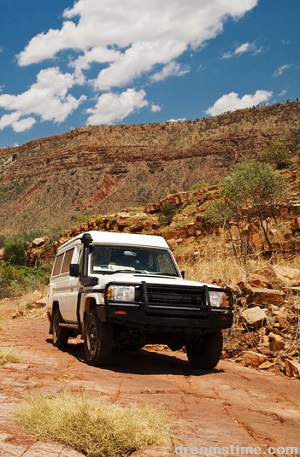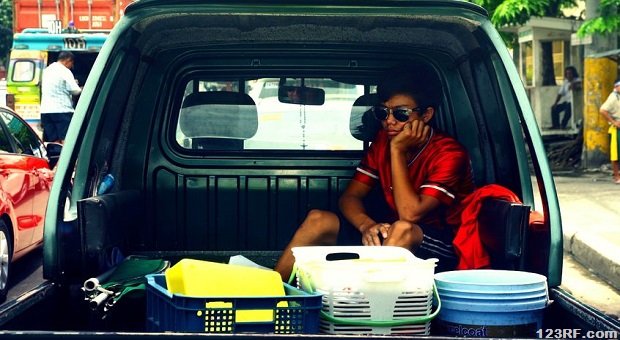If you’ve been around prepping for any time at all, you’ve probably seen some of the vehicles that people are planning on using for their bug-out vehicle.
Some of them are rather wild, including such things as wheeled armored personnel carriers, home-made armored trucks, school busses and other military vehicles. I even saw an armor support vehicle (for providing logistical support to tanks in warfare) that had a camper built onto it.
I can see where some of these people get their ideas from; they want a vehicle that will get them through anything, especially blocked roads. There’s just one big problem I can see with their choices; those vehicles are so obvious, that it’s like they are putting up a neon sign saying “Preppers Live Here.”
{adinserter usdeception}When most people talk about a survival vehicle, they’re really talking about a bug-out vehicle. But that’s not the only survival use of a vehicle. Many people will be bugging in and still need a vehicle.
Actually, unless someone has that famous cabin in the woods to bug out to, most people are better off bugging-in, unless things get so bad that they are forced to leave. So, whatever vehicle someone buys or builds for survival really needs to take into account both bugging in and bugging out.
What You Need
So, what does a good survival vehicle need to have, in order to be useful in both situations?
- Enough seating for your whole family. Regardless of whether you’re staying home or bugging out, you really don’t want to have to use more than one vehicle.
- Plenty of cargo space for carrying your survival equipment and supplies.
- Off-road capability can be extremely useful, as there’s a pretty good possibility that roads will be filled with stalled or out-of-gas vehicles.
- Good gas mileage (I realize this contradicts the previous items).
- Not obvious. The more that can be done to make your vehicle blend in to the surroundings and not look like a survival vehicle, the better. It’s also good to have a color that doesn’t stand out.
Selecting a perfect vehicle for your needs requires making some compromises. Those people who have obvious bug-out vehicles have decided to trade OPSEC (operational security) for having a vehicle that will allow them to get out of Dodge, no matter what is happening.
While that works for them, it may not work for someone else.
What Are You Preparing For

If you are fortunate enough to have a cabin in the woods, which you have stocked for bugging out and your plan is to bug out at the first sign of trouble, then an obvious bug-out vehicle would make a lot more sense for you, than it would for someone who is planning on staying at home.
Regardless of what your plans are, you still need a bug-out plan of some sort. Therefore, at least one of your vehicles needs to be something that you could use for a bug-out.
Considering that you’re not planning on bugging out early, chances are that you’ll be bugging out as part of a mass exodus. That means that the roads are going to be crowded with vehicles, some of which will run out of gas or overheat in traffic.
With that in mind, your best bet for a survival vehicle is a SUV or pickup truck. Ideally, you should have a four wheel drive one, even though that means it will get lower gas mileage. If possible, you should compensate for this by adding a second gas tank, increasing your total fuel capacity. That way, you’ll be able to go farther on the gas that you are carrying.
What Else to Prepare
Don’t just stop with buying the vehicle though; put the effort into getting it ready for the trip. To start with, that means making sure that it is mechanically sound, with good tires. Once you have that out of the way, then you need to start modifying the vehicle to make it better for a survival situation.
Some things you might want to consider include:
- Gun racks
- Puncture-proof tires
- A bed cover or shell (if it’s a pickup truck) or rooftop storage (if it’s a SUV)
- Interior racks for holding equipment
- Gas can rack
- Kevlar in the door panels
- Installing window security film on the inside of the windows to make them more break resistant (against rocks, etc. – won’t stop a bullet)
- Extra lights
- Two-way radio
- Tools and survival equipment
- Some way of sleeping in it (if there is enough room)
- Voltage inverter (for using 120 VAC electrical equipment)
- Accessory outlets (for charging phones, etc.)
- A second engine battery
The list of modifications you might want to consider is literally endless. The thing to do is to put it together as you think you will need it and then do a bug-out trial run some weekend. You’ll learn a lot that weekend about how well your vehicle works, as well as come up with a number of other ideas to make it work better.
The main idea here is to have a vehicle which will get you to where you are going; not to have the prettiest car on the street.
Like I said before, you’ll end up having to make some compromises. Just make sure that the compromises that you make are ones which will help you fulfill your plans. Don’t do them, just because someone else did.
This article has been written by Bill White for Survivopedia.









RAPTOR55 | August 20, 2014
|
There is a very high probability that I won’t have to bug out but if I must, it will be for a very short distance and will do it in my solar-powered, EMP protected motor home without having to travel any major or secondary roads. O fcourse that would change if conditions change. I would rather stay put in my prepped home if at all possible.
Pingback:Small Car Fixing on a Survival Budget | The Prepper Dome | September 24, 2014
|
Pingback:Preserving Gas: Tips For Low Consumption Driving | Survival skills, survival guns, survival guide | February 23, 2015
|